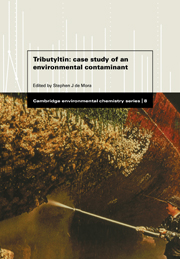Book contents
- Frontmatter
- Contents
- Contributors
- Preface
- 1 The tributyltin debate: ocean transportation versus seafood harvesting
- 2 Industrial manufacture and applications of tributyltin compounds
- 3 The analysis of butylated tin compounds in the environment and in biological materials
- 4 The occurrence, fate and toxicity of tributyltin and its degradation products in fresh water environments
- 5 The distribution and fate of tributyltin in the marine environment
- 6 Biological effects of tributyltin on marine organisms
- 7 TBT-induced imposex in neogastropod snails: masculinization to mass extinction
- 8 Environmental law and tributyltin in the environment
- 9 The efficacy of legislation in controlling tributyltin in the marine environment
- Index
7 - TBT-induced imposex in neogastropod snails: masculinization to mass extinction
Published online by Cambridge University Press: 04 August 2010
- Frontmatter
- Contents
- Contributors
- Preface
- 1 The tributyltin debate: ocean transportation versus seafood harvesting
- 2 Industrial manufacture and applications of tributyltin compounds
- 3 The analysis of butylated tin compounds in the environment and in biological materials
- 4 The occurrence, fate and toxicity of tributyltin and its degradation products in fresh water environments
- 5 The distribution and fate of tributyltin in the marine environment
- 6 Biological effects of tributyltin on marine organisms
- 7 TBT-induced imposex in neogastropod snails: masculinization to mass extinction
- 8 Environmental law and tributyltin in the environment
- 9 The efficacy of legislation in controlling tributyltin in the marine environment
- Index
Summary
Introduction
Prosobranch gastropods exhibit all types of sexuality but in most the sexes are separate and unchanged throughout the life of the individual (Fretter & Graham, 1962). Before the late 1960s, distinguishing males from females was a routine matter involving a simple examination to determine whether or not a specimen possessed a penis. The situation was radically changed around 1970 when surveys of populations of four neogastropod species in different parts of the world (both coasts of the United States and Atlantic Europe) revealed that some females were now penis-bearing (see Gibbs, Pascoe & Bryan, 1991c). In his short note on one of these species, the nassariid Ilyanassa obsoleta, Smith (1971) coined the term ‘imposex’ to describe ‘a superimposition of male characters onto unparasitized and parasitized females’; his subsequent work (Smith, 1980, 1981a–d) established the primary cause of female masculinization (development of a penis and vas deferens (sperm duct)) to be exposure to the leachates of marine antifouling preparations containing tributyltin (TBT) compounds. In the case of I. obsoleta, no major effects on population ecology and reproduction were detectable, but later studies of other species demonstrated that imposex resulting from exposure to remarkably low TBT concentrations can, in fact, profoundly disrupt breeding activity and lead to population extinctions on a broad scale.
Marine antifouling paints containing tributyltin (TBT) compounds were introduced in the mid-1960s and rapidly gained popularity because of both their effectiveness and ease of maintenance.
- Type
- Chapter
- Information
- TributyltinCase Study of an Environmental Contaminant, pp. 212 - 236Publisher: Cambridge University PressPrint publication year: 1996
- 40
- Cited by



